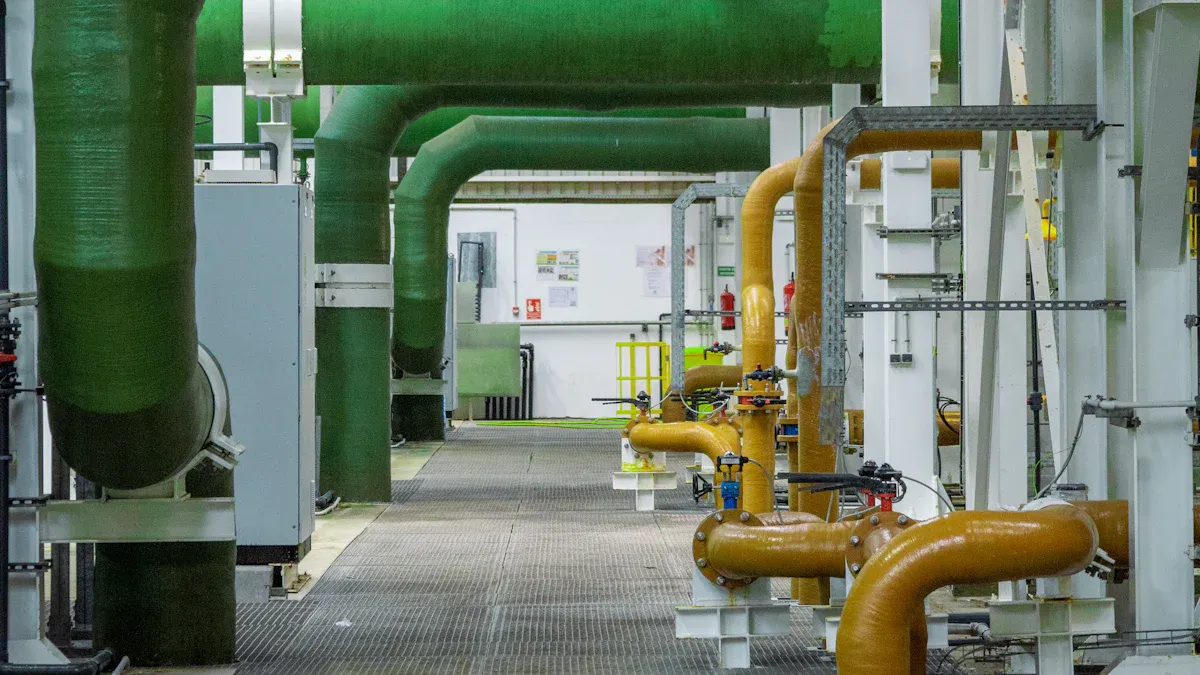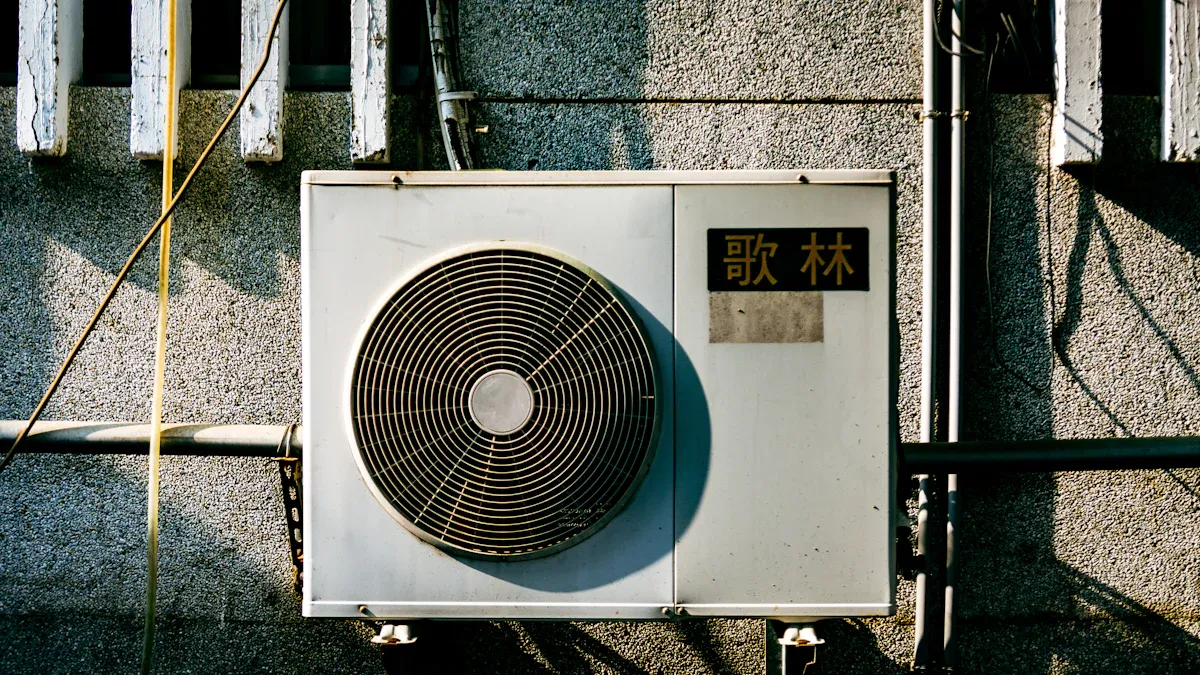Why Industrial Chillers Save Energy and Costs

Energy-saving industrial chillers change how cooling is managed. These systems use less energy, helping industries save money and waste less. For example:
Switching old cooling systems in data centers can cut building costs by up to half.
Better cooling lowers server work by 10-20%, cutting power use by about 50%.
Using an industrial chiller makes work more efficient and keeps costs low. It’s a smart choice for industries that care about saving money and helping the environment.
Key Takeaways
Using energy-saving chillers can lower electricity bills by 50%.
Smart controls in chillers stop energy waste and work better.
New chillers cut pollution, helping the planet and businesses.
Energy-saving chillers need less fixing, saving money and time.
Reusing heat from chillers saves energy and cuts heating needs.
Energy Efficiency in Industrial Chillers

Advanced Cooling Technologies
Modern cooling systems use new technology to save energy. One example is thermoelectric cooling, which skips using regular refrigerants. These systems are eco-friendly and very accurate. They keep temperatures steady and work fast, making them great for food storage. For instance, thermoelectric modules help fridges use less energy while keeping food fresh.
These systems can be designed to fit different needs. You can use them in factories, data centers, or food processing plants. By choosing advanced cooling, you save energy and improve how things work.
Automated Load Controls
Automated controls help chillers work better by adjusting cooling as needed. They stop energy waste during times of low use. For example, New Belgium Brewing cut downtime by 50% and boosted equipment efficiency by 20% using these controls. Automation makes cooling systems smarter and more effective.
Adding automated controls reduces energy waste and protects your equipment. They prevent overheating or undercooling, which can cause problems. With automation, your chiller lasts longer and works reliably.
Reduction in Energy Waste
Old cooling systems often waste energy, but newer designs fix this. Meeting rules like ASHRAE 214-2023 ensures chillers are efficient. For example, a Texas data center saved 32% on energy costs with dual-cooled chillers. Its Power Usage Effectiveness (PUE) improved to 1.15, showing big savings.
Using less energy lowers costs and helps the environment. Efficient chillers use less electricity, cutting carbon emissions. They’re a smart choice for businesses that want to save money and go green.
Cost Savings with Energy-Efficient Chillers
Lower Electricity Bills
Energy-efficient chillers help cut electricity use and save money. New chillers use smart technology to cool more efficiently. They need less power, using up to 30% less energy than older ones. This drop in energy use means big savings over time.
Here’s an example of how much you could save monthly:
Month | Savings ($) |
|---|---|
June | |
July | 600 |
These numbers show how upgrading chillers can lower costs. By saving on electricity, you can spend money on other business needs.
Reduced Maintenance Expenses
Energy-efficient chillers break down less often, saving repair costs. Their advanced designs reduce wear, so they need fewer fixes. Older chillers often need more repairs, but newer ones avoid this.
Automated controls also help by spotting problems early. Fixing small issues prevents expensive damage later. Over time, lower maintenance costs can save you thousands. Buying an energy-efficient chiller saves on both power and upkeep.
Longer Equipment Lifespan
Energy-efficient chillers last longer because they work smarter. They avoid overheating and reduce stress on parts. This means you won’t need to replace them as quickly.
These chillers also pay off by saving energy over time. The money saved helps you get the most out of your purchase. Choosing an efficient chiller protects your investment and avoids frequent replacements.
Environmental Benefits of Energy Efficiency
Reduced Carbon Emissions
Energy-efficient chillers lower carbon emissions by using less power. Old cooling systems use outdated methods that waste energy. New chillers work better and waste less energy. By using less power, they release fewer harmful gases into the air.
For example, factories switching to efficient chillers can cut emissions a lot. This helps the planet and supports global climate goals. Every effort to lower emissions makes the Earth cleaner and healthier.
Repurposing Waste Heat
Modern cooling systems let you reuse waste heat for other needs. Heat reclamation systems collect extra heat from cooling processes. Instead of wasting it, this heat can warm water or buildings.
This method saves energy and reduces the need for separate heaters. Many industries use this to save money and work better. Reusing waste heat saves energy and helps the environment by using resources wisely.
Supporting Sustainability Goals
Energy-efficient chillers help you meet your sustainability goals. They use less energy and lower your carbon footprint. Businesses that care about the environment attract eco-friendly customers.
You can also pair these chillers with renewable energy or green building plans. Using efficient chillers shows you care about the planet and your business. Sustainability becomes part of who you are and how you work.
Applications of Industrial Chillers

Manufacturing and Production
Industrial chillers help factories by keeping machines cool. They stop overheating, which avoids delays and boosts work speed. For example, the market for energy-saving chillers may grow from $4.1 billion in 2022 to $6.3 billion by 2030. This growth is due to more automation and stricter environmental rules.
New tech like magnetic bearing chillers and smart IoT chillers improve cooling. These systems let you check and adjust temperatures instantly. With a 23% rise in factory investments by 2024, chillers are now essential for modern production plants.
Food Processing and Storage
Food storage needs steady temperatures to keep items safe and fresh. Industrial chillers provide cooling that meets these needs. Thermoelectric cooling keeps food at the right temperature for longer.
The demand for energy-saving chillers is growing fast. The modular chillers market in the U.S. could hit $667.1 million by 2035. Using advanced chillers lowers energy use and meets food safety rules. This saves money and makes your work more efficient.
Data Centers and IT Infrastructure
Data centers create heat because servers work hard. Cooling systems are needed to stop overheating and keep things running. Energy-saving chillers with oil-free and inverter tech adjust to changing loads.
As data centers grow, better cooling systems are needed. Companies like Meta spend billions on data centers, showing cooling is important. Industrial chillers keep equipment safe, cut energy costs, and maintain good temperatures.
Energy-saving industrial chillers are a great way to save money. They lower power bills, need fewer repairs, and last longer. These chillers also help the planet by cutting emissions and reusing heat.
More industries want eco-friendly chillers to meet green rules.
Hotter weather means portable cooling is needed more often.
New technology makes chillers cheaper to run and more dependable.
Using these chillers improves work, helps the environment, and supports sustainability. 🌱
FAQ
What is an industrial chiller, and why is it important?
An industrial chiller cools machines or processes by removing heat. It saves energy, lowers costs, and helps the environment by wasting less power.
How do industrial chillers save energy in a data center?
Industrial chillers adjust cooling based on server activity. This uses less energy, cuts electricity costs, and improves savings.
Can industrial chillers help with sustainability goals?
Yes, they lower harmful emissions and reuse extra heat. These chillers support eco-friendly plans and meet green standards.
What industries benefit most from industrial chillers?
Factories, food storage, and data centers gain the most. Chillers keep work efficient, save energy, and ensure steady cooling.
How do modern cooling systems differ from older ones?
New systems use smart tech like automatic controls and thermoelectric cooling. They save energy, need fewer repairs, and last longer than old ones.
See Also
Maximize Your Walk-In Chiller's Efficiency With These Tips
Choosing The Right Industrial Water Chiller: A Guide
A Comprehensive Guide To Water Chiller Unit Operations
Comparing Energy Efficiency: ARKREF CO₂ Units Vs. Traditional Systems
Boosting Industrial Cooling Performance With ARKREF CO₂ Refrigeration

